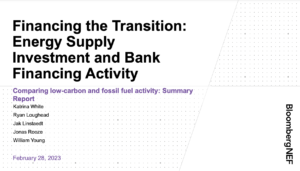Full Title: Financing the Transition: Energy Supply Investment and Bank Financing Activity
Author(s): Katrina White, Ryan Loughead, Jak Linstaedt, Jonas Rooze, and William Young
Publisher(s): BloombergNEF
Publication Date: February 28, 2023
Full Text: Download Resource
Description (excerpt):
The pace at which low-carbon energy supply is scaled up will dictate the rate at which fossil fuels are phased down. The most frequently referenced climate scenarios indicate that, on average, to adequately displace fossil fuels to limit the average global temperature rise to no more than 1.5°C, we need to increase the Energy Supply Investment Ratio (new investment in low-carbon to fossil-fuel supply) from the current ~1:1 to a minimum of 4:1 by 2030. This means for every dollar invested in fossil fuel supply in 2030 this should be matched with four times as much being invested in low-carbon energy supply.
In this analysis, we use existing public and commercially available data to assess banks’ energy sector financing activity in 2021 and its allocation between low-carbon supply and fossil fuels. By generating a ratio for this, we can approximate the extent to which banks’ financing activity is aligned to investment in the real economy and by extension to that needed by 1.5°C-aligned climate scenarios.
To align the specifications across climate scenarios and financing activity, this analysis focuses on energy supply (the infrastructure built to extract, generate and distribute energy from fossil fuels or low-carbon resources) and differentiates this from energy demand (the consumption of energy through transportation, industrial or other energy use). This approach adheres to the definitions used to derive the 4:1 ESIR and enables a comparison between investment and financing. We conclude the following:
- ● At 0.8:1 the 2021 Energy Supply Banking Ratio, or ESBR, is broadly in line with that of the real economy investment activity of 0.9:1. Bank financing for energy supply totalled $1.9 trillion. Of that, $842 billion went to low-carbon energy projects and companies, and $1,038 billion went to fossil fuels.
- ● Bank financing mainly goes to companies and projects in North America, China and Europe. The ESBR, varies between these regions with North America and China tied at 0.6:1, and Europe at 2.6:1. In part, this reflects the role that each region plays in global energy supply and consumption.
